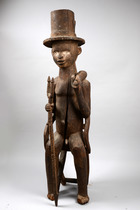Rare "obu" shrine figure · Nigéria, Igbo · ID: 3042075
Description
wood, brown patina, strongly encrusted in some areas, remains of white pigment, sitting on a detailed replica of a european lawn chair, carved with top hat, a finely carved prestige staff with forked ending in his right hand and a trumpet (elephant horn) in his left, typical “ichi” scars on forhead and temples, slightly dam., missing parts (both legs), cracks, rep. (breakages: both forearms, hat brim in several places);
in some Igbo groups the head of a compound, in addition to his own house, had a shed or a low-walled building called “obu”. The “obu” were primarily meeting-houses but were also in some respects spirit houses, in that they also housed the collective ancestral shrines of the groups to which they belonged. They were decorated with figures of men and women of varying ages and occupations warriors with guns, head-hunters with cutlass and trophy head, old women with ivory anklets, younger women carrying pots or nursing babies and other characters taken from everyday life. By the 1930’s the fashion had died out and only survived in a few meeting houses in Abiriba and Ohafia. The finest of these, with the most striking figures, was that of the Asaga, which included 32 life-sized statues arranged under the veranda and inside the house. Present male statue, a tutelary divinity, richly adorned with items of prestige (dignitary staff, hat, horn trumpet, chair) comes from one of these “obu”.
L’objet Rare “obu” shrine figure numéro d’objet 3042075, a fait partie de l’enchère 85th Tribal Art Auction en 4 mars 2017 pour la dernière fois le Zemanek-Münster Hôtel des ventes et avait le numéro de lot 270.
Vous trouverez d’autres Figures et autres types d’objets populaires sur nos pages thématiques associées. Notre page sur le thème Art africain pourrait également vous intéresser.
Littérature comparée
Jones, G. I., The art of Eastern Nigeria, Cambridge 1984, p. 108 ff
Publications
AHDRC: 0139808








